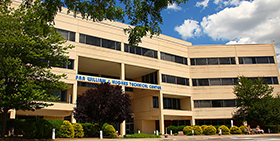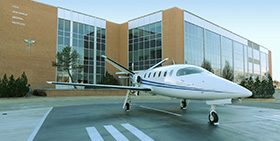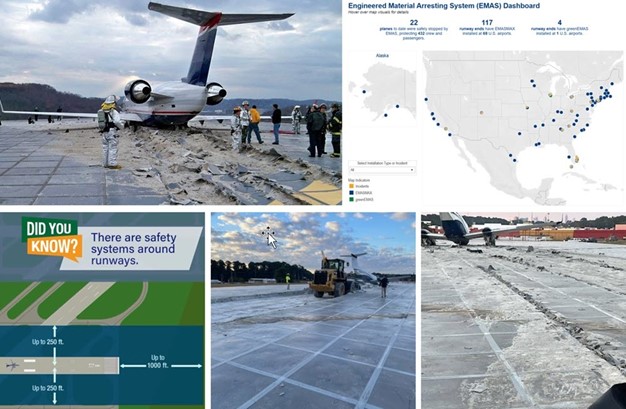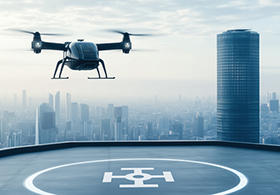Technology Transfer (T2) Program
Overview
The FAA’s T2 program advances innovation by facilitating the identification and development of innovative technologies and processes for the benefit of the US public, its economy, and the global aviation community.
Jump to a section: ⇣ Technology Transfer Legislation | ⇣ FAA Federal Labs | ⇣ Technology Transfer Highlights | ⇣ Licensing Opportunities | ⇣ References | ⇣ Technology Transfer FAQs | ⇣ Contact Us
Benefits
The FAA T2 program promotes the pooling of FAA expertise, facilities, and other resources with those of industry and academia to drive innovation. Cooperative research and development agreements (CRADAs) permit the T2 program to establish agreements offering benefits to both the agency and our partners:
Agency
- Early insight into innovative technology
- Research in support of the certification process
- Improved regulatory framework
- Enhanced aviation safety
Partner
- Access to cutting-edge FAA labs and expertise
- Reduced time to market
- First option for licensing
- Provide some protection from disclosure under the Freedom of Information Act
Technology Transfer Legislation
 The Stevenson-Wydler Technology Innovation Act of 1980 laid the groundwork for future technology transfer initiatives to facilitate the transfer of federally-funded technology to the private sector.
The Stevenson-Wydler Technology Innovation Act of 1980 laid the groundwork for future technology transfer initiatives to facilitate the transfer of federally-funded technology to the private sector.
That same year the Bayh-Dole Act granted universities and small businesses ownership of inventions developed with federal funds, stimulating innovation. In 1986, the Federal Technology Transfer Act expanded these efforts by allowing for CRADAs and streamlined patent licensing.
More recent legislation, such as the America Invents Act, has further refined the intellectual property landscape, impacting technology transfer processes. Collectively, these laws aim to bridge the gap between federal research and commercial applications, fostering economic growth and addressing societal challenges.
FAA Federal Labs
FAA William J. Hughes Technical Center (WJHTC) for Advanced Aerospace
 The WHJTC for Advanced Aerospace in Atlantic City, New Jersey, is focused on advancing the United States National Airspace System (NAS) and sustaining its continued safe and efficient operations. The Technical Center's partners and highly diverse, technical workforce use a vast array of state-of-the-art laboratories to enable research, engineering, development, test, and evaluation of advanced aviation technologies. Key focus areas include Fire Safety, Airport R&D Technology, Software and Systems, Structures and Propulsion, and Separation Standards Analysis.
The WHJTC for Advanced Aerospace in Atlantic City, New Jersey, is focused on advancing the United States National Airspace System (NAS) and sustaining its continued safe and efficient operations. The Technical Center's partners and highly diverse, technical workforce use a vast array of state-of-the-art laboratories to enable research, engineering, development, test, and evaluation of advanced aviation technologies. Key focus areas include Fire Safety, Airport R&D Technology, Software and Systems, Structures and Propulsion, and Separation Standards Analysis.
Learn more about the FAA William J Hughes Technical Center for Advanced Aerospace
Civil Aerospace Medical Institute
 The FAA Civil Aerospace Medical Institute (CAMI) in Oklahoma City, Oklahoma, is the medical certification, research, education, and occupational health wing of the FAA's Office of Aerospace Medicine. The goal of our activities is to enhance aviation safety. Key focus areas include aerospace medical certification, aerospace medical education, aerospace human factors research, aerospace medical research, and occupational health.
The FAA Civil Aerospace Medical Institute (CAMI) in Oklahoma City, Oklahoma, is the medical certification, research, education, and occupational health wing of the FAA's Office of Aerospace Medicine. The goal of our activities is to enhance aviation safety. Key focus areas include aerospace medical certification, aerospace medical education, aerospace human factors research, aerospace medical research, and occupational health.
Learn more about the Civil Aerospace Medical Institute
Learn more about the FAA
Technology Transfer Highlights
EMAS: Revolutionizing Runway Safety
The Engineered Materials Arresting System (EMAS) is an innovative safety installation designed to stop aircraft at the end of runways, using crushable material that allows tires to sink in and decelerate the plane safely. Developed by the FAA in the 1990s, EMAS is particularly effective in areas where traditional safety zones are not possible due to space constraints.
The FAA Technology Transfer program, located at the William J Hughes Technical Center for Advanced Aerospace in Atlantic City, executed a Cooperative Research and Development Agreement (CRADA) to further advance EMAS technology. For nearly 30 years, EMAS has revolutionized aviation safety by preventing runway overruns at airports nationwide improving safety and preventing accidents.
Check out this video and this blog to learn how this life-saving technology works, why it’s critical for high-risk runways, and where the FAA is taking it next.
The FAA and Urban Air Mobility (UAM) Integration
 The FAA recognizes the potential of UAM to revolutionize transportation by enabling flight about congested city areas. Anticipating this future, the FAA is taking proactive steps to integrate UAM into the NAS. The dream of flying above city traffic is becoming a reality through projects like the UAM Airspace Management demonstration.
The FAA recognizes the potential of UAM to revolutionize transportation by enabling flight about congested city areas. Anticipating this future, the FAA is taking proactive steps to integrate UAM into the NAS. The dream of flying above city traffic is becoming a reality through projects like the UAM Airspace Management demonstration.
This real-world demonstration assessed the feasibility, safety, and effectiveness of UAM operations within the NAS. Live flight demonstrations validated key elements of the UAM Concept of Operations, providing valuable data to guide future implementation.
The successful demonstration is an important step in paving the way for routine UAM operations within the existing airspace system. By establishing predictable rules and procedures, these new entrants can safely share airspace with traditional flights. The FAA is committed to seamlessly introducing this new technology while maintaining the highest safety standards. This proactive approach ensures the aviation community is prepared to embrace the future of urban air mobility.
Licensing Opportunities
US20200340935A1: Generating and Determining the Products of Premixed Combustion of Solid Materials in a Microscale Fire Calorimeter. Measures heat release rates of very small samples (1-10 mgs) without the need to simultaneously measure mass loss rate and the heat of combustion of the fuel gases. Allows for microscale, accurate, and convenient techniques for the generation and determination of the type and nature of combustion species produced over the full range of fire stages from early stage (over-ventilated) fires to late-stage (under-ventilated/high-toxicity) fires.
Potential Applications:
- Safety testing and certification: The calorimeter can be used in safety testing for various materials, chemicals, and products. Industries such as fire safety, aviation, and automotive could benefit.
- Materials Science Research: Researchers studying combustion processes, energy materials, and chemical reactions may find this technology useful.
- Quality Control in Manufacturing: Industries that produce materials prone to combustion (e.g., plastics, textiles) can use the calorimeter for quality control.
- Environmental Monitoring: The calorimeter could contribute to environmental monitoring by assessing combustion emissions.
- Educational Institutions: Universities, colleges, and technical schools teaching chemistry, materials science, or engineering may be interested.
US10514454B1: Techniques for mitigating the effects of complex structures on radar systems. A system and method for improving target detection in complex environments like wind farms. It involves calculating multiple threshold values for each radar cell based on historical data and comparing them to determine the optimal threshold. This approach helps to reduce false alarms caused by wind turbines and other structures while enhancing target detection.
Potential Applications:
- Federal Agencies: Those using radar systems in complex environments (e.g., NORAD, DOD, DHS, NOAA)
- Wind Farm Operators: Companies managing wind farms could be interested in licensing this technology to enhance their radar systems.
- Aviation Authorities: Explore partnerships with aviation authorities or air traffic control agencies that need radar systems capable of handling complex environments.
US8604965B2: Apparatus and method to generate and detect virtual targets. A system and method that generates virtual targets & manipulates amplitude of the radiated signal so that the position information is received by the test aircraft only. It involves calculating virtual aircraft positions based on real-world data, encoding this information into a radio signal, and transmitting it to a nearby aircraft. The signal is designed to be undetectable by other aircraft. The test aircraft receives the signal, decodes it, and interprets the virtual aircraft as real targets in its vicinity. This system can be used for testing aircraft systems and equipment without the need for actual aircraft.
Potential Applications:
- Aircraft Collision Avoidance Systems: The patent’s method of generating and detecting virtual targets could enhance existing collision avoidance systems. By creating virtual targets that represent nearby aircraft, pilots and onboard systems can receive early warnings and take evasive actions.
- Military Applications: Military aircraft and drones could benefit from this technology. Virtual targets could simulate enemy aircraft or other threats during training exercises, allowing pilots to practice evasive maneuvers without real-world risks.
- Drone Traffic Management: As drone usage increases, managing drone traffic becomes crucial. Virtual targets could represent drones in the vicinity, helping operators avoid collisions and maintain safe distances.
- Autonomous Vehicles: Beyond aviation, this concept could apply to autonomous ground vehicles. Virtual targets representing pedestrians, cyclists, or other vehicles could improve safety and navigation.
- Simulation and Testing: The technology could be used in flight simulators, testing scenarios where multiple aircraft interact. It allows realistic simulations without physical risks.
- Research and Development: Researchers studying air traffic management, radar systems, or communication protocols might find this technology useful for experimentation and validation.
US20220101736A1: Robust Techniques for the Collection and Management of Data from Data Sources in an Unmanned Aircraft Systems (UAS) Operations Environment. A system for collecting and managing data from UAS. The system is designed to be robust and flexible, and can be used to collect data from a variety of sources. The system includes a data-agnostic platform that can host a variety of clients and client services. The system also includes a configuration mechanism that allows the system to be automatically configured based on user input.
Potential Applications:
- Drone Applications: data in support of waivers for UAS applications in agriculture, construction, infrastructure inspection, real estate, etc.
- Internet of Things (IoT): This system could be adapted to manage data from a network of IoT devices, such as sensors in buildings or machines. It could collect data from these devices, ensure compatibility and format the data for analysis, and then generate reports or trigger actions based on the data.
- Scientific Research: To collect data from various instruments and experiments. This system could streamline data collection and processing, handle data from different sources, organize it based on pre-defined parameters, and perform automated analysis based on user-defined configurations.
- Manufacturing: Integrating data from a variety of sensors and machines that generate data. This system could be used to collect data from these sources, monitor production lines, identify potential problems, and optimize manufacturing processes.
- Finance: To manage and analyze financial data from various sources, such as stock markets, customer transactions, and credit reports. This could help them identify trends, make better investment decisions, and manage risk.
- Logistics and Supply Chain Management: To help track vast amounts of data related to shipments and inventory. This system could be used to collect data from different points in the supply chain, ensure data consistency, and generate reports or trigger actions based on real-time information.
Learn more – United States Patent and Trademark Office
References
DOT
- USDOT Research Hub
- DOT T2 and Lab to Market Initiatives
- FAA Policy - Order 9550.6B Technology Transfer Program
- FAA Technical Library
- Civil Aerospace Medical Institute Library
Other
- Federal Laboratory Consortium's (FLC) Technology Transfer Desk Reference
- The FLC's "Green Book" summarizes Technology Transfer legislation and executive orders since the Stevenson-Wydler Technology Innovation Act of 1980.
- Federal Technology Transfer Act of 1986
- United States Patent and Trademark Office
- National Institute of Standards and Technology (NIST) - Federal Laboratory Technology Transfer Reports
- FAA Partnership Program – Features links to FAA labs and describes their capabilities
Technology Transfer FAQs
Q: What legislation authorizes Cooperative Research & Development Agreements (CRADAs)?
A: Since the 1980s CONGRESS has enacted a series of laws to promote technology transfer and provide incentives, some of which are highlighted here. The Stevenson-Wydler Act of 1980 established the Office of Research and Technology Applications (ORTA) at all Federal Laboratories and required a budget be established for T2 activities. The Bayh-Dole Act of 1980 entitled small businesses, universities, and not-for-profit organizations to obtain titles to inventions developed with federal funds. The Federal Technology Transfer Act of 1986 enabled government owned and operated laboratories to enter into Cooperative Research and Development Agreements (CRADAs) and to negotiate licensing arrangements for patented inventions made at the laboratories. The National Competitiveness Technology Transfer Act of 1989 allowed information and innovations that were created through a CRADA, or brought into a CRADA, to be protected from disclosure to third parties. The National Technology Transfer and Advancement Act of 1995 amended the Stevenson-Wydler Act to grant US companies intellectual property rights to inventions arising from a CRADA with a federal laboratory and gives the collaborating party the right to choose an exclusive or nonexclusive license for a pre-negotiated field of use for an invention resulting from joint research under a CRADA.
Q: What FAA office executes Cooperative Research & Development Agreements (CRADAs) for the agency?
A: The Office of Research and Technology Applications (ORTA), which is located at the William J Hughes Technical Center for Advanced Aerospace, Research & Development Management Division, executes all FAA CRADAs. Email: NATL-Technology-Transfer@faa.gov
Q: Can the FAA establish a CRADA with another Federal Agency?
A: Yes, 15 USC 3710a(a)(1) states that the Federal lab director may enter into a CRADA on behalf of the agency with: “…. other Federal agencies; units of State or local government; industrial organizations (including corporations, partnerships, and limited partnerships, and industrial development organization.” Read more
Q: Can the FAA provide funds under a CRADA?
A: No, the FAA never can provide funding to a collaborating partner under a CRADA; however, the FAA can provide personnel, services, and property. The partner may provide personnel, services, property, and funds (Note: the process to accept funds is currently under review).
Q: What information learned under a CRADA cannot be shared?
A: Trade secrets or confidential information supplied by a partner are never disclosed. Federal employees are bound by 18 U.S.C. §1905 not to disclose non-public information including trade secrets or confidential business information under threat of civil/criminal penalties. This statute applies to all Federal duties and so project-specific non-disclosure agreements are not needed.
Q: What information learned under a CRADA can be shared? Is it possible to delay disclosure of that information from a Freedom of Information Act (FOIA) request?
A: Before the agreement is signed, the FAA and collaborating party negotiate what resulting information and data can be shared. The agreement also describes the process for clearly labeling and marking resulting proprietary information that will not be disclosed. In addition, some resulting data and information can be exempt from disclosure under a FOIA request for up to 5 years. This provides time to pursue a patent. See more information about the FOIA.
Q: Who has the rights to a patent under a CRADA?
A: If the invention is made solely by the partner’s employee, the partner has the right to pursue a patent. If the invention is a joint FAA/partner outcome, the partner has the first option to pursue a patent, but must provide the Federal Government a non-exclusive, non-transferable, irrevocable, worldwide, royalty-free license to practice and have practiced an Invention for or on behalf of the U.S. Government for research or other government purposes. If the partner elects not to pursue the patent, the Federal Government has the right to pursue it.
Contact Us
For further information contact the FAA technology transfer program manager at NATL-Technology-Transfer@faa.gov.
